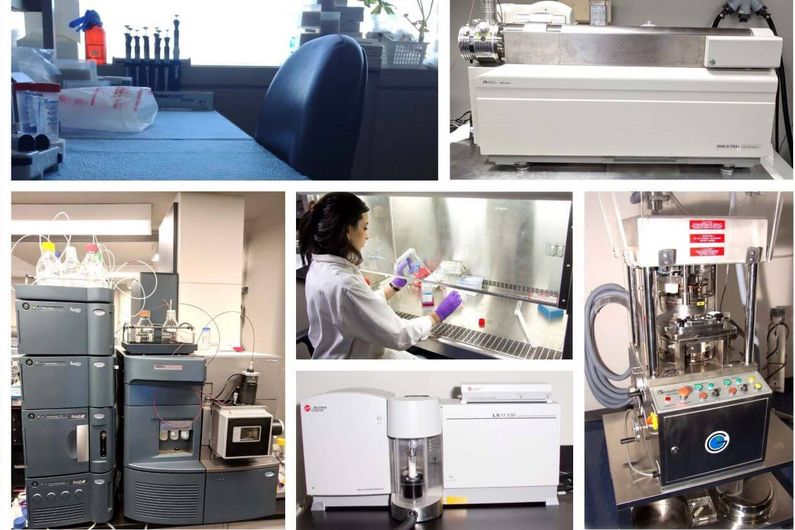UdeM's Biopharmaceutical Unit: playing a key role in drug development
- UdeMNouvelles
06/08/2021
While the COVID-19 pandemic caused slowdowns in many fields, it underscored the importance of UdeM's drug discovery units.
For Grégoire Leclair, of the many things the COVID-19 pandemic drew attention to, one big one was the need for drug research. "When the first lockdown occurred in March 2020, everything closed for a few weeks,” recalls the Université de Montréal pharmacy professor and researcher, director of his faculty’s Biopharmaceutical Unit. “But it wasn't long before the Quebec government designated our work an essential service. We were one of the first to restart."
The pandemic highlighted the Biopharmaceutical Unit's contribution to the drug manufacturing chain. The local pharmaceutical research landscape has changed significantly since Leclair created the unit in 2010.
"At the time, several large pharmaceutical companies had closed their Montreal operations and their researchers went to work for smaller businesses,” he remembers. “As a result, from 2010 to 2015 the local ecosystems were in a state of flux. Now that the dust has settled, we're seeing projects emerging from the academic and research communities and being picked up by pharmaceutical companies for development and commercialization."
The creation of COVID-19 vaccines is a good example of this type of arrangement. "If the vaccine name includes the name of a small biotech firm, university or other organization, we know who did the research before the pharmaceutical company brought the product to market," says Leclair. In his view, the trend demonstrates what the Biopharmaceutical Unit or similar initiatives can achieve by collaborating with other research groups, academic teams and industrial firms working in the area of drug discovery and development.
An essential role
The Biopharmaceutical Unit's role is to gather information about the different molecules that are submitted to it and then assess their chances of becoming marketable drugs. "The first step in drug development is animal testing to see if the product produces the desired therapeutic effect and to make sure it's not toxic,” explains Leclair. “If a client thinks they've got a promising drug, they'll come see me. Our group analyzes the molecule's other properties, such as its solubility, stability and required formulation.”
Professor Leclair and his team then aim to answer questions such as: Will the molecule will be stable once prepared as medication? Can it be stored at room temperature for a reasonable amount of time? Once absorbed into the body, how will it be metabolized? Will the drug need to be injected or could it be taken orally? The answers given will help them determine whether or not the product is worth commercializing.
There are several advantages to having the unit at UdeM, says Leclair. "Consider the researchers at the Institute for Research in Immunology and Cancer [IRIC] or the professors in the Faculty of Medicine: they often have the right ideas and animal models for testing and doing proofs of concept, but they lack the tools and expertise to assess the other aspects of their products. If they have several molecules to analyze, I can provide the information they need to determine which ones are worth pursuing. Without us, a lot of projects would stall because critical information is missing.”
Looking to the future
At the outset, the Biopharmaceutical Unit had only two employees: its founding director and a research officer. Today, the team includes Professor Valérie Gaëlle Roullin, scientific advisor; Mihaela Maria Friciu, formulation specialist and coordinator; Martin Jutras, HPLC-MS/MS specialist; and Isabelle St-Jean, bioanalysis specialist.
Leclair wishes he could say that one of the unit's medications had made its way to market, but so far none has reached that stage. "In the drug development field, most ideas don't pan out. In fact, when something works, it's the exception!" Still, he believes several of the IRIC's oncology and immuno-oncology projects show promise.
He’s particularly excited about two initiatives. The first is a registry of magistral formulations that could make it possible for patients to get quick access to existing drugs that are either out-of-stock or hard to access. This registry would be developed in collaboration with UdeM's Continuous Flow Synthesis Laboratory.
His second goal is to step up the Biopharmaceutical Unit's current activities by expanding its research tools and instruments. This would allow the team to conduct other types of tests and learn more about the molecules produced by the university's researchers. "We're hoping to strengthen our current collaborations so that when products are developed at UdeM, they're almost ready to be submitted to regulatory agencies," Leclair says.













